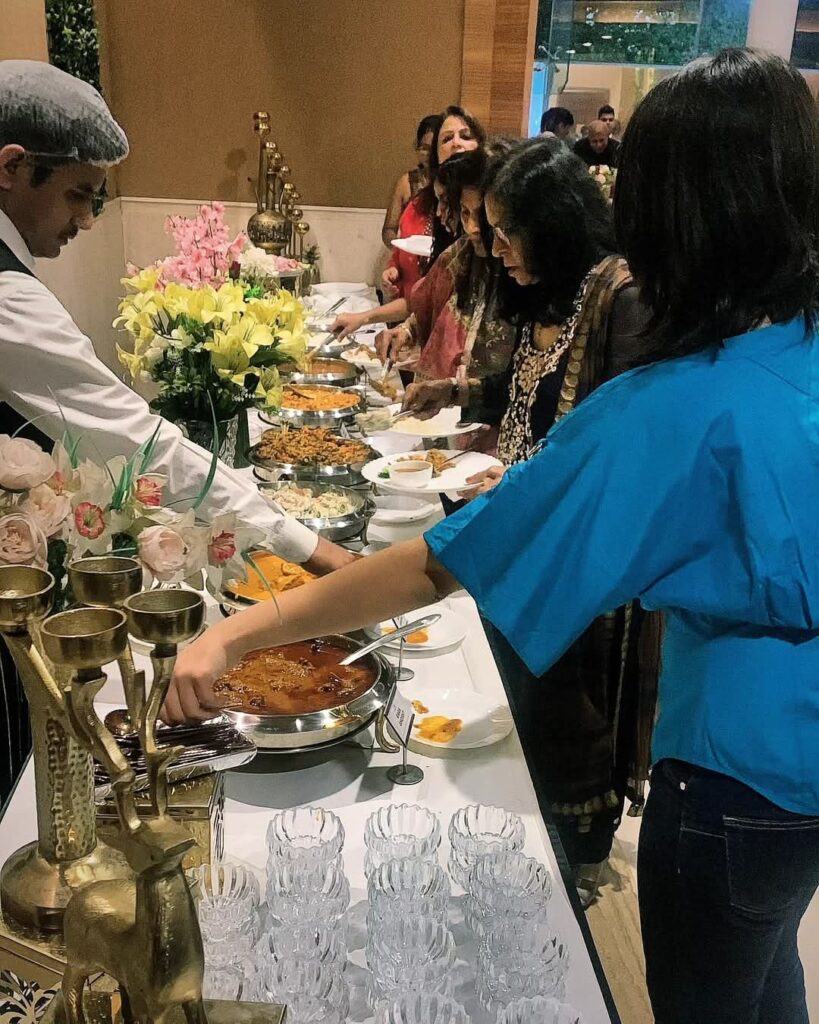The four most common types of Caterers in South Delhi, generally categorized by the type of event they serve, are:
Catering services are utilized by a vast and diverse clientele, broadly falling into two main categories: corporate clients and private/social clients. The specific needs of each group determine the type, scale, and style of the service required.
1. Corporate and Business Clients
This segment represents a significant portion of the catering market, focusing on professional events that often occur on-site during work hours or off-site for more formal gatherings. Key users include:
Office Managers and Administrative Staff: The most frequent users, ordering food for daily, weekly, or monthly needs, such as:
Employee team lunches or staff appreciation meals.
Working meetings, board meetings, or client presentations.
Regular recurring meal programs (e.g., as an alternative to a traditional cafeteria).
Event Planners and Marketing Teams: They hire caterers for larger, often high-stakes events intended to promote the company or its products.
Conferences, Conventions, and Trade Shows: Providing meals, coffee breaks, and refreshments for thousands of attendees.
Product Launches and Galas: Requiring high-quality, often customized, and elegantly presented cuisine to align with the company’s brand.
Training Sessions and Seminars: Supplying basic, efficient, and consistent breakfast or lunch options.
Specialized Industries:
Healthcare (Hospitals, Clinics): Ordering meals for staff, patient families, or medical sales presentations.
Educational Institutions (Schools, Universities): Catering for alumni events, graduations, academic conferences, and faculty meetings.
Production Companies: Requiring on-set catering (craft services) for film and TV crews.
2. Private and Social Clients
These users contract caterers for personal events, celebrations, and gatherings where the focus is on a memorable, customized experience for invited guests. Users include:
Individuals and Couples:
Weddings: This is a major, often complex, catering event, involving customized menus, tasting sessions, and a full-service experience (e.g., servers, bar service, dishware).
Private Parties: Ranging from intimate dinner parties and holiday celebrations to large-scale birthday parties, anniversaries, and retirement parties.
Family Events: Including baby showers, bridal showers, engagement parties, and funerals/wakes.
Community and Non-Profit Organizations:
Fundraisers and Galas: Formal, large-scale events that require sophisticated menu and presentation to impress donors and stakeholders.
Community Festivals and Public Events: Often utilizing concession catering for a high-volume, crowd-pleasing menu (e.g., hot dogs, popular street foods).
In essence, anyone or any organization that requires food and beverage service for a group of people—when they either lack the means to prepare it themselves or need professional, specialized service for an important occasion—becomes a user of catering services. The main drivers are convenience, quality, time savings, and the professional presentation that a caterer provides.
Creating a catering service menu requires a strategic balance of culinary appeal, operational feasibility, and profitability. It’s more than just a list of dishes; it’s a reflection of your brand and capabilities. Here’s a breakdown of the key steps:
1. Define Your Niche and Target Market
Before listing a single item, determine who you’re serving and what type of events you’ll specialize in.
Target Market: Are you catering for corporate luncheons, elegant weddings, casual private parties, or something else? Your clientele dictates the price point and formality of the food.
Niche: Decide on your culinary focus (e.g., farm-to-table, ethnic cuisine, comfort food, upscale desserts). This specialization helps you stand out.
2. Structure Your Menu for Flexibility and Clarity
A well-structured menu is easy for clients to read and easy for you to execute. Categorize your offerings clearly.
Creating a catering service menu requires a strategic balance of culinary appeal, operational feasibility, and profitability. It’s more than just a list of dishes; it’s a reflection of your brand and capabilities. Here’s a breakdown of the key steps:
1. Define Your Niche and Target Market
Before listing a single item, determine who you’re serving and what type of events you’ll specialize in.
Target Market: Are you catering for corporate luncheons, elegant weddings, casual private parties, or something else? Your clientele dictates the price point and formality of the food.
Niche: Decide on your culinary focus (e.g., farm-to-table, ethnic cuisine, comfort food, upscale desserts). This specialization helps you stand out.
2. Structure Your Menu for Flexibility and Clarity
A well-structured menu is easy for clients to read and easy for you to execute. Categorize your offerings clearly.
Export to Sheets
3. Focus on Operational Efficiency and Profitability
A beautiful dish that takes four chefs three hours to prepare won’t make you money. Your menu must be scalable and transportable.
Batch Cooking: Choose dishes that can be partially or entirely prepared in advance and quickly finished on-site (e.g., braised meats, roasted vegetables).
Equipment Limits: Select recipes that don’t all require the same limited equipment (e.g., avoid a menu where every dish needs to be baked simultaneously).
Costing: Calculate the food cost for every item. Aim for a target food cost percentage (often 25-35%). This ensures a healthy profit margin when multiplied by your labor, overhead, and profit markups.
Seasonal Items: Include “Market Price” items to leverage fresh, local, and cheaper seasonal ingredients, increasing your profitability and quality.
4. Write Enticing Descriptions
The way you describe the food is as important as the taste. Use vivid, sensory language that highlights quality ingredients and preparation methods.
Avoid: “Chicken with Rice”
Use: “Pan-Seared Statler Chicken Breast served with a creamy mushroom and tarragon reduction, alongside a pilaf of wild rice and toasted almonds.”
5. Include Customization and Dietary Options
A modern catering menu must cater to diverse needs.
Customization: State that you are “Happy to customize” or that “Substitutions may be available.” This shows flexibility.
Allergens and Preferences: Clearly label dishes that are Gluten-Free (GF), Vegetarian (V), Vegan (VG), or Dairy-Free (DF). Offer at least one appealing option in each of these categories.
6. Set Clear Pricing and Terms
Be transparent about how you charge.
Pricing: Clearly state whether prices are per person, per piece, or per platter. Specify minimum order sizes or guest counts.
Additional Fees: Note mandatory charges like service fees, delivery fees, staffing costs, and equipment rentals (e.g., chafing dishes, linens).
Pro Tip: Start with a small, focused menu that you can execute perfectly. As your business grows, you can gradually expand your offerings.



